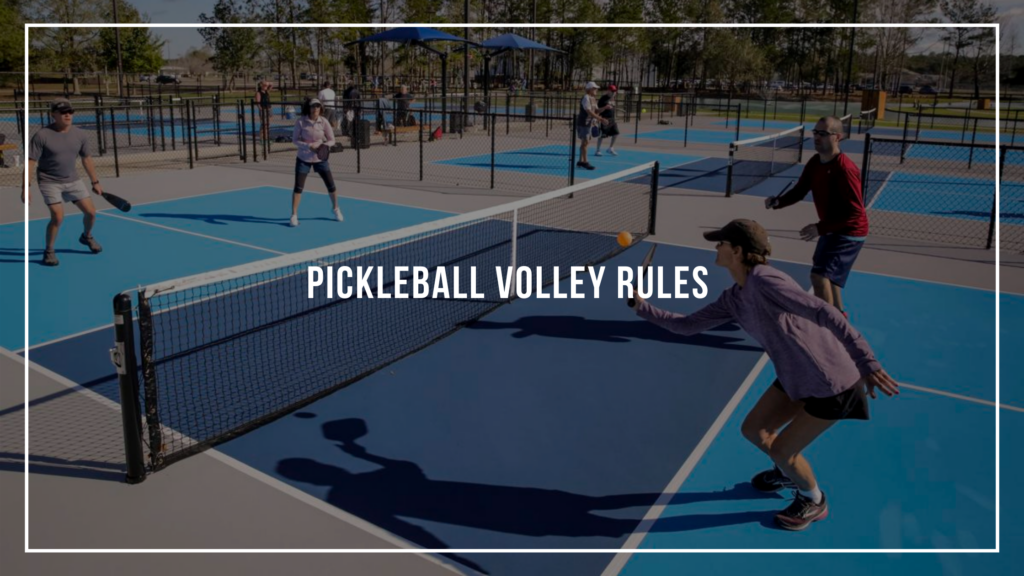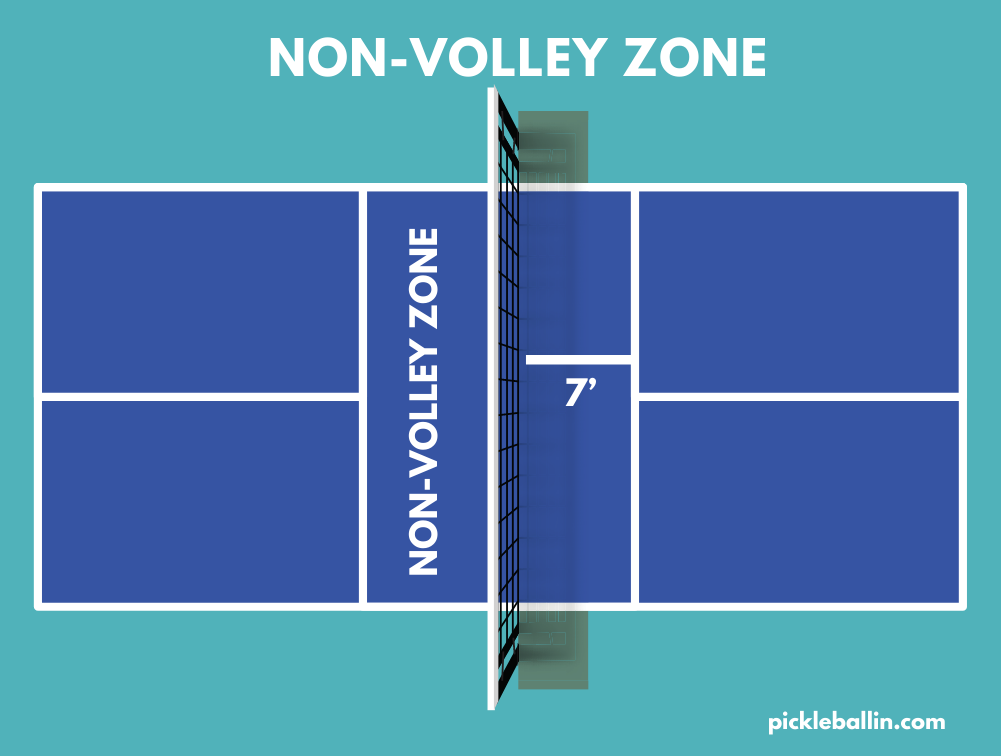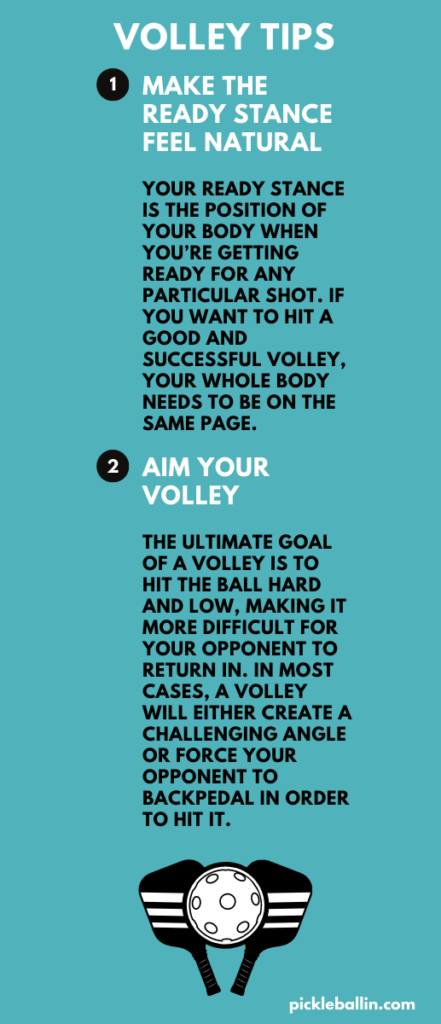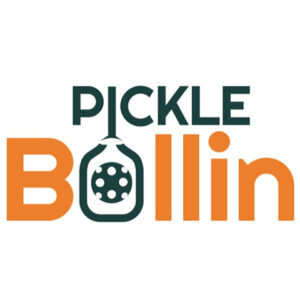
If you enjoy a good workout, a fun game, and sports with giggle-inducing names, then pickleball might be the right activity for you. This paddle ball sport combines the best of tennis, ping pong, and badminton to deliver a two- or four-player game of hitting a ball over a net.
Like every other official sport, pickleball comes with specific rules and regulations. Today, we’re going to focus on pickleball volley rules and how you can nail the technique of the volley.
We’ll start with the most basic of questions: what is a volley in pickleball? From there, we can turn up the intensity a bit and really delve into one of the basics of this high-energy sport.
If you’re looking for a complete beginner’s guide to pickleball check out: Pickleball Strategy: Complete Beginners Guide !
!
What is a Volley in Pickleball?
According to the official rules outlined by USA Pickleball, a volley is “a ball hit in the air before it bounces onto the court during a rally.” So, essentially, a volley entails a successful hit that occurs before the ball is allowed to bounce.
Many pickleball players utilize volleys to strategize their gameplay, making it more difficult for the receiving team to return during a rally. Volleys are also useful in returning a challenging ball that’s been hit low and hard. With a quick reaction, players can hit a return volley to save the point.
Check out this video to see the 3 common mistakes that are made when volleying:
Why is the Volley Important in Pickleball?
The volley is important in pickleball because it is a technique that can be effectively used to win a lot of points. If you’re new you may not know that the game of pickleball is mostly won or lost at the net. Meaning, your volley technique can help you win or lose a considerable amount of points which is a game-changer! Volleys make up a much more significant part of pickleball strategy and of pickleball playmaking.
Tennis has many shots such as side spin, forehand, backhand, flat, slice, block, topspin, drop shot, crosscourt, and so on. In comparison, pickleball has fewer shots such as forehand, backhand, dink, drive, block shot, and volley. Learning how to volley in pickleball is essential to your game!
When Should You Volley?
It would be best if you hit a volley whenever you have the chance, except when you are in the non volley zone, of course:
- Volleys take time away from the receiving team.
- Volleys eliminate the possibility of getting a bad bounce.
- Volleys are more offensive shots. So if you’re playing offense, you should hit a volley shot.
3 Tips for Hitting Volley Shots
Here are three things you need to know for hitting volley shots:
Make Sure to Keep the Tip of Your Paddle Up: Your paddles tip should almost always be pointing upwards. You want to create a “V” shape with the paddle and your wrist. The paddle needs to be above the wrist, and the tip of the paddle should be towards the ball.
Make Contact with the Ball in Front of Your Body: You want to be sure that the paddle is always in front of you. This is so you can make solid contact in front of your body. Players often find that it is easier to do this when hitting a backhand volley. This is because the shoulder is used more as they cross their body. However, when hitting a forehand shot, players usually bring their elbows in – closer to their bodies – this causes them to catch the ball a bit behind them. This is considered a “wristy” shot, which lacks power and control.
Grip Pressure: It’s essential to be aware of how tightly you hold your paddle. You want to grip the paddle in your fingers, not the palm of your hand. If you hit the ball and notice it doesn’t have a “pop” to it, you need to adjust your grip. Be sure to hold the paddle firmly so that it is stable when you make contact with the ball.
Types of Volleys in Pickleballs
All of the shots in Pickleball are executed either through forehand or backhand. However, the volleys can be classified into four different shots.
Reactive Volley
A reactive volley is a defensive shot that has the goal of keeping the point alive. There’s really no follow-through when hitting a reactive volley shot. In this volley the paddle face is not open or closed.
Push Volley/Dink Volley
A push/dink volley is used along with a dink shot. This is the most common type of volley shot in pickleball. In a push/dink volley, you have more time to react to the ball, meaning you drive your response shot towards the receiving team either with an open or a slightly closed paddle face. If you’re pushing up, you want to keep the paddle face slightly open. If you’re pushing down, you want to keep the paddle face slightly closed.
Roll Volley
A roll volley is an offensive shot where you add topspin to the ball. You use an open paddle face with this volley and your stroke should go from low to high.
Catch Volley
The catch volley is by far the most difficult shot to do. This shot is usually used to counter a fast response from your opponent. The goal of this shot is to apply backspin so it takes the sting out of the initial shot. Essentially, you’re slicing the ball so it creates backspin, which slows the ball down.
Volley Rules
Volleys are common athletic moves made across the board in sports like tennis, table tennis, and, of course, badminton. However, when you are participating in a game of pickleball, there are a few rules you have to follow for your volley.
Because a volley is usually a quick, reactionary move in pickleball, it’s nice to know that you can perform it using either a backhand or forehand approach; there are no rules against either type of swing.
However, players performing a volley cannot implement a backswing – meaning that they must avoid a swinging motion. Instead, a player should hit the ball using a “blocking” motion. The goal during a volley is to push the ball over the net rather than hit it.
When volleying, your paddle must be in a vertical position so that the face is square to the ball. Focusing on this can help you ensure that you don’t accidentally use a backswing. This position helps promote the blocking and pushing motion that we mentioned above.
You may only hit a volley during any given point after the ball has bounced twice. A player must wait until the ball has bounced from the serve and then bounced again on the return. Then, a volley can be hit at any point during that rally.
How to hit a Forehand Volley in Pickleball?
When playing pickleball, you will want to do a forehand volley when your opponent is near the kitchen. When hitting a forehand volley, you can drive the ball and force the opposing team off balance or place it softly.
There is a bit of a learning curve when it comes to executing volleying properly. You must ensure the face of your paddle is aligned with the net. Once you’ve done that, you now need to focus on how to grip the paddle. It is best to grip the paddle at a 45-degrees. Your hands and wrist must be stable when you gently push the paddle forward. This is so the ball is guided correctly and goes where you want it to.
Hitting a Forehand Volley in Pickleball
- Get into the ready stance.
- Keep your paddle aligned with the net
- Hold the paddle at a 45-degree angle
- Make sure your hands and wrists are stable
- Limit how much your arms move
- Swing the paddle back
- Hit the shot; when doing this, hit the ball away from the opposing team.
How to hit a Backhand Volley in Pickleball?
A backhand volley shot requires you to close your body when hitting the shot. This means you want to bring the paddle close to your body before releasing the shot. The great thing about hitting backhand is you can either hit a slow ball or a fastball.
Backhand Volley with Backspin
Unfortunately, when hitting a backhand volley, we lose some power. However, there is something you can do to make up for that. You can add more backspin. Backspin slows the ball down; this causes the ball to drop pretty quickly, which means your opponent has to react quickly to keep the point going.
You can apply backspin in a couple of ways. The first thing you want to do is open the paddle’s face slightly when it connects with the ball. This movement allows the ball to get over the net. Once you hit the ball, you want to do a slice down immediately. This applies backspin to the pickleball ball.
Backhand Volley with Topspin
Backhand volleys with topspin is an excellent move for those who want to hit a faster ball. Backhand volleys with topspin are a less commonly used shot because of their faster pace. Because of the faster speed, these shots have a lower percentage of working. On the other hand, if this shot is executed correctly, you’ll make the game extremely difficult for your opponent.
To hit a backhand volley with topspin, you’ll want to move the face of the paddle in an up and down motion. When swinging, the path needs to be from low to high. This allows you to control the height and distance of the ball. This shot makes the ball drop and bounce up quickly. This, more often than not, throws your opponent off balance.
Hitting a Backhand Volley in Pickleball
- Get into the ready stance.
- Make sure the paddle is up and above your wrist.
- Make sure the movement comes from your elbow, not your shoulders
- The paddle face need to be perpendicular to the court
- Ensure you don’t swing the paddle in a downward motion
- Hit the ball
Non-Volley Zone

One of the most critical rules concerning a volley is the pickleball non-volley zone. This zone is a portion of the court that’s commonly referred to as “the kitchen” or “kitchen zone.”
A pickleball court is very similar to a tennis court, but it uses different lines in various locations to split up the playing area. The non volley zone, or the kitchen, is the portion of the course between the net and the non-volley line.
The non volley line is positioned seven feet from the net at the front of the court on both sides, giving players a considerable amount of space where volleys are prohibited.
In the non volley zone, players cannot hit a volley. If a player hits a volley while in this zone, the result of that play will be a fault. Therefore, a player can only hit a ball in the non volley zone once that ball has bounced on the ground.
Over the Line Rules
The no volley zone implements strict rules to ensure that every player is clear on what they can and cannot do. The over the line rules help clarify a few details about the kitchen.
The non volley zone line or kitchen line, which is placed seven feet from the pickleball net, is strictly a part of the non-volley zone. That being said, players cannot touch the kitchen line with their feet while volleying. If they do, the hit is considered a “dead ball” or a fault.
In fact, it’s not just the feet that can’t touch the kitchen line – it’s any part of a participating player. This actually includes clothing and equipment as well. So, when a player is volleying just behind the kitchen line, they must not allow their paddle to cross the line. Otherwise, the play will result in a fault.
Additionally, should any piece of a player’s clothing or equipment fall into the non-volley zone during a volley, then the result will be a fault. In other words, make sure you hold onto your hat during an intense volley moment.
Players must adhere to the over the line rules even after the ball has gone over the net and to their opponent’s side. If their opponent misses the shot and the ball is dead, you still can’t touch this line or enter the non-volley zone.
Partner Rules
The level of seriousness presented by the non-volley zone in pickleball skyrockets when you extend to partners’ play (or four players). When playing on a team, the same rules of the kitchen still apply.
However, things can quickly become intense. A partner can physically hold back their teammate to prevent them from crossing into the non-volley zone. So, if you spot your partner losing their balance, you can pull them away from the zone to impede their momentum.
Just be aware that you also cannot cross into the zone, nor can anything you’re wearing or using. You may be able to pull your partner away, but if your paddle crosses over in the process, the point is invalid.
Can I Ever Enter the Kitchen?
The short answer is: yes, you and your partner can step foot in the kitchen. You may do so anytime that a volley is not in play. You can even hit a ground stroke from the kitchen, so long as the ball has bounced on the ground first.
The best pickleball practice is to be aware of your footing at all times. Players can absolutely move out of the kitchen to hit a volley, but they must make sure that both feet have been established outside of the non volley line before they do so.
Volley Tips

Using a volley can be extremely effective in both singles and doubles pickleball at securing points for your team. This game-changing shot has proven to be an essential strategy, often resulting in very difficult-to-hit balls.
So how can you maximize your pickleball game using the volley? Check out some of these tips to try during your next match.
Make the Ready Stance Feel Natural
Your ready stance is the position of your body when you’re getting ready for any particular shot. If you want to hit a good and successful volley, your whole body needs to be on the same page.
Everyone’s ready stance may look a little bit different, but generally, you should aim for the same stance every time you hit a volley. Stand facing forward with your feet shoulder-width apart, and knees slightly bent.
When prepping for a volley, hold your paddle with a backhand grip. In this grip, your paddle should be parallel to the net when you go to make the shot.
Preparing your stance in this way will ensure that you’re ready to hit either a backhand or forehand volley without having to adjust your grip or your wrist position. Likewise, nailing your ready stance allows you to make your shot quickly.
Taking the time to practice your ready stance can make all the difference. You want this stance to feel as natural as possible so that you don’t have to overthink it when the shot comes your way.
Aim Your Volley
The ultimate goal of a volley is to hit the ball hard and low, making it more difficult for your opponent to return in. In most cases, a volley will either create a challenging angle or force your opponent to backpedal in order to hit it.
That being said, learning to aim your volley can prove to be a highly coveted skill in the game of pickleball.
When you hit a volley, you should aim to direct the ball away from your opponent. Doing so forces them to move faster and reach awkwardly, which often results in a point for your team. Practicing the angle of your paddle can help you achieve this.
You can also work on opening the face of your pickleball paddle more to increase the distance of your volley, driving the ball deep down the court.
Conclusion

Pickleball volley rules are like any other sports rules: you simply have to learn them and put them into practice. In no time, you will know them like the back of your hand – or paddle.
A volley in pickleball can be a very effective and impressive shot if you work hard and master the technique. By adhering to the rules of the non volley zone and staying out of the kitchen, you could be serving up some extra points.
Stick to these rules and give it a go. You may have just discovered your new favorite sport!
Looking for more? Here are some of our other guides we recommend:
Learn: About Pickleball , Why is it Called Pickleball?
, Why is it Called Pickleball? , Pickleball Rules
, Pickleball Rules , Pickleball Court Dimensions
, Pickleball Court Dimensions , What is Pickleball?
, What is Pickleball? , What is a Fault in Pickleball?, What is the Double Bounce Rule in Pickleball?
, What is a Fault in Pickleball?, What is the Double Bounce Rule in Pickleball? , and Pickleball Singles vs Doubles – Strategies and Rules
, and Pickleball Singles vs Doubles – Strategies and Rules .
.
Equipment: Best Pickleball Clothes for Men and Women , Best Pickleball Accessories And Must-Have Gear
, Best Pickleball Accessories And Must-Have Gear , Best Pickleball Paddle in 2021, and Men’s Pickleball Shorts.
, Best Pickleball Paddle in 2021, and Men’s Pickleball Shorts.
